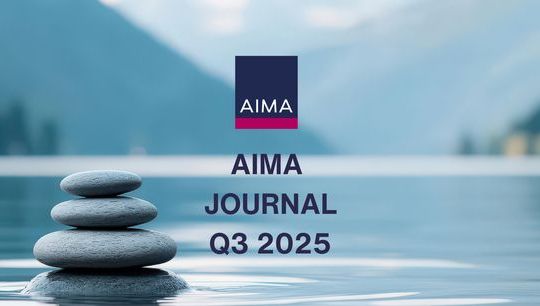CEO blog: What’s in store for the hedge fund industry in 2020?
By Jack Inglis, CEO AIMA
Published: 09 January 2020
Assets under management for the hedge fund industry continue to break new records. The coming decade heralds a new paradigm for the hedge fund industry, led by business models being disrupted by two mega-trends: increased technological innovation and a greater focus on environmental, social and governance (ESG) challenges. Every industry in the world will be impacted; hedge funds being no different. Below are the key trends that we see impacting the hedge fund industry throughout 2020.
From manager-led products to investor-led solutions
Faced with what is now a buyer’s market, hedge funds are forging deeper partnerships with investors. These are characterised by customised investment mandates as well as offering value advisory services. This change reflects a growing trend within the hedge fund industry as it moves away from the product-led environment of the past to a marketplace increasingly populated by more bespoke investor solutions, as explored in our paper Perspectives.
Technology will continue to disrupt hedge funds from front to back office
Every industry in the world is either being disrupted or will soon face disruption by technology. The advent of cutting-edge statistical and computational tools is increasingly forcing hedge funds to re-evaluate how they operate and invest. Technology is becoming more of a necessity for hedge funds in order to analyse the masses of data becoming more readily available. According to recent projections, the alternative investment industry will spend US$1.7 billion on alternative data in 2020. Over the coming year and throughout the next decade, we expect hedge funds to implement alternative data and use forms of machine learning right across their business which will impact on all aspects of the hedge fund value chain. AIMA will be publishing the first of their papers which looks at hedge funds use of alternative data in Q1 this year.
ESG factors to play an increasing role in allocation decisions
The hedge fund industry is being disrupted not only by new technologies but also by new investor expectations. The use of ESG criteria when making an investment was very much a niche activity 5-10 years ago, but this has become a top priority for asset managers globally. Investors are increasingly demanding portfolio solutions that, as well as minimising risks and maximising returns, also take social and environmental concerns into account, with responsible investment now becoming a rampant theme across the alternative investment industry. Over the next year, efforts to integrate ESG across investment products will intensify led by investors and managers engaging on its potential to be a performance enhancer (future proofing themselves against ESG risks) rather than just an added cost, as well as an increasing regulatory requirement for ESG factor disclosures. AIMA’s next paper examining how hedge funds are integrating ESG will be published on February 6th.
Diversity and Inclusion to take the lead in the talent management revolution
Asset management firms will step up their efforts to attract and retain the best talent. Increasingly fund managers are realising that to survive today’s highly competitive and innovative environment, they need to look beyond the traditional pool of talent from the finance sector. Hedge fund managers and investors alike increasingly recognise the role that a culture promoting diversity and inclusion can bring – creating better decisions and better investment outcomes. Over the next year, diversity and inclusion will become a business imperative for all hedge funds. There are many steps the industry can take to help improve their culture of diversity and inclusion, outlined further in our D&I paper.
Hedge fund industry moves beyond the 2 and 20 structure
2019 saw the continued fee compression of recent years across the entire fund industry. We don’t see any reason for that to change in 2020, with investors continuing to demand managers to be more flexible in their fee arrangements. We continue to witness a range of variations to the 2&20 compensation model with one theme being the trade-off between lower or no management fees and higher performance-based fees.
2020 will see the emergence of the ‘fulcrum fee’ where there is a more modest fee on assets and the actual profit-sharing fee, the typical two and twenty part of the fee, only charged on any excess performance delivered by the fund. By the same token, investors understand that alpha is highly difficult to produce on a consistent basis. They understand that it is an artisanal product and as such are willing to pay a premium to those who can deliver. Our research launched earlier this year explores how investors and fund managers are exploring new approaches to negotiate fees and fund terms.
Private credit to go from niche to mainstream
Amidst a lower yield environment, increasing amounts of investor capital are being allocated to private markets. This is providing investor portfolios with exposure to alternative pockets of growth and consistent income streams that were previously inaccessible. Many credit focused hedge funds continued to develop hybrid vehicles to exploit opportunities in the private markets.
The structural retrenchment of banks and the growing preference of borrowers to work with a sophisticated counterparty is also creating a growing demand for investor capital in many lending markets. Private credit funds (including hedge funds) are becoming increasingly adept at meeting investor demand for private credit assets in two ways. Firstly, through tailored investment strategies to realise the opportunities that exist in these markets and secondly, by customising their products to investors’ specific requirements. These are taking the form of more hybrid-like (private equity/hedge fund) structures. As private credit managers build on their existing presence in core markets, they are also breaking new ground in less developed markets via new investment strategies. With the market set to surpass $1tn total assets under management in the coming years, having exposure to both public and private markets is likely to become a more prominent trend within alternative investments. To read more about the future of private credit, please see AIMA’s Financing the Economy here.
Alternatives investment industry will continue to grow
Buoyed by a solid year of performance, where the average hedge fund reported 9% net of fees[1], total industry assets under management tested new highs in 2019. Amidst geo-political uncertainty and a tighter monetary policy by central banks globally, early forecasts for market performance in 2020 suggest that market volatility and interest rate levels (that have been so low for so long) will inevitably reverse. With the introduction of these two factors, hedge funds demonstrated ability to deliver strong risk adjusted returns as well as much needed portfolio diversification for investors, will help boost returns further in addition to the hedge fund industry seeing a return to capital inflows in 2020. Having seen private markets dominate investor attention over the past few years.
The geographic footprint of the alternative investment industry will continue to diversify from the historically largest regions of the US and UK into more emerging markets like China, supported by moves from the local regime to open its financial markets to foreign capital and the increasing sophistication of talent and investment infrastructure in the region[1] As reported by various hedge fund data vendors at the end of Nov 2019.







